As a parent, I’m always searching for fun and creative ways to help my toddler learn and explore. That’s why I absolutely love the idea of busy boards. Busy boards give little hands and curious minds a safe space to play, touch, and figure out new things, right at home. Busy boards let my child grow their skills and learn through hands-on discovery, all while having a great time.
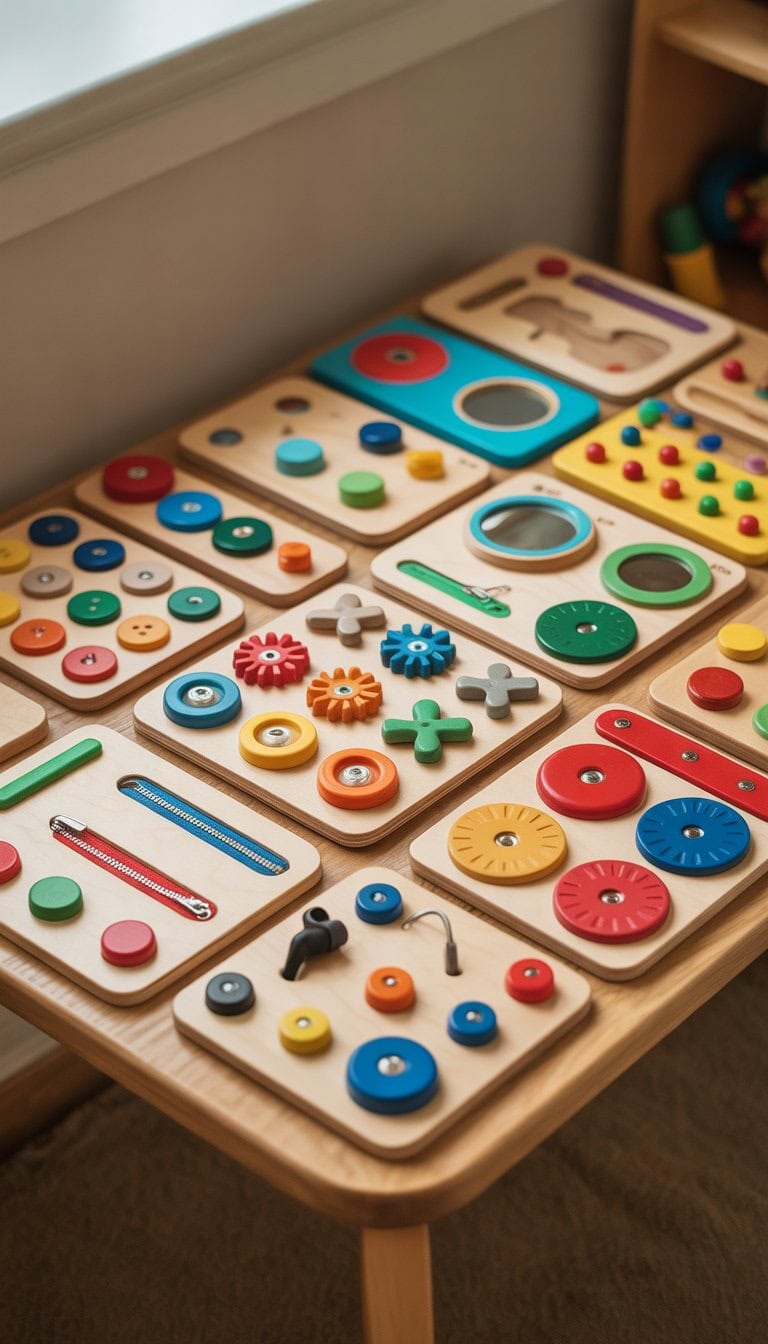
There’s something magical about watching my toddler light up with excitement as they open a latch or turn a spinner. Each moment with a busy board is a mix of fun, challenge, and joy—for both of us. If you’re also hoping to spark your child’s creativity and give them healthy ways to play, making your own busy board might be the perfect project for you.
Sensory Texture Board with sandpaper, fuzzy fabric, and bumpy surfaces
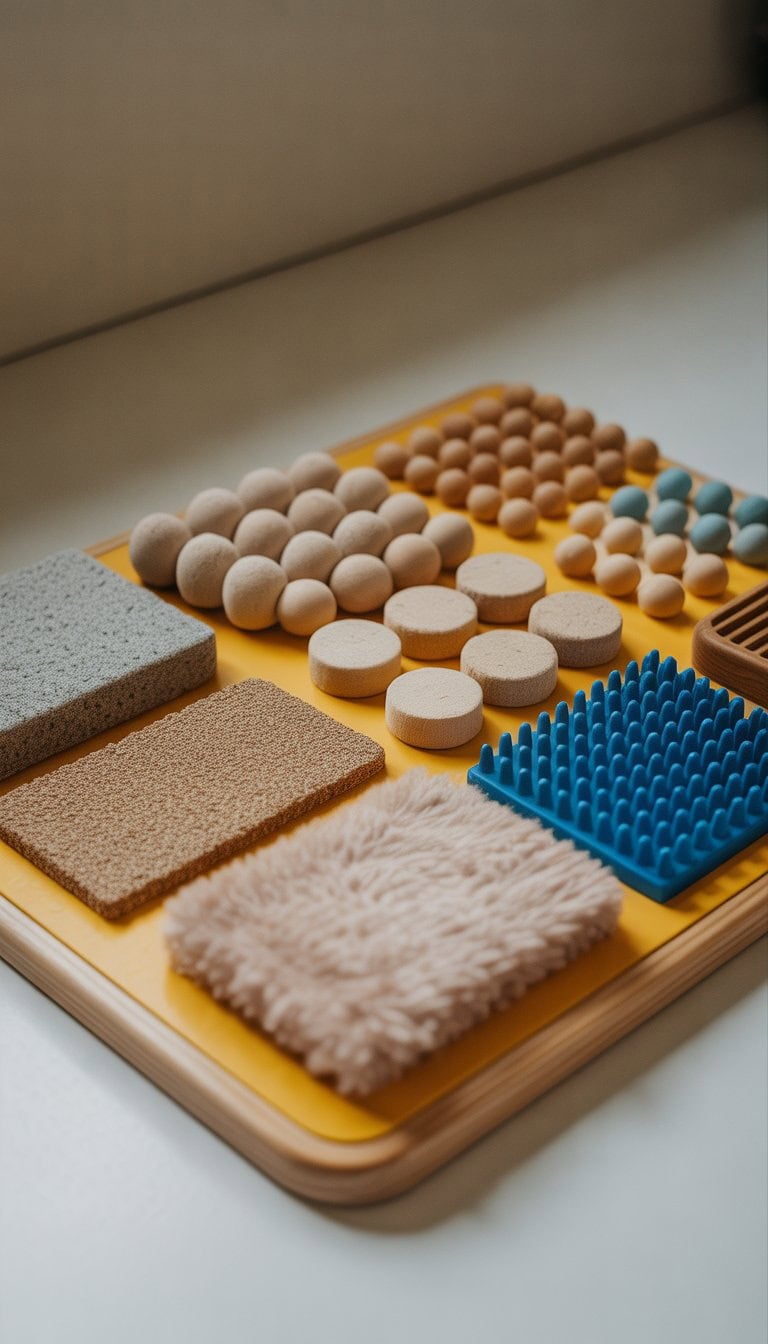
I love making sensory texture boards because they’re simple and keep little hands busy. For this one, I gather things like sandpaper, fuzzy fabric, and bumpy materials. Kids always seem curious about new textures, so these items grab their attention right away.
I usually cut the pieces into easy-to-touch shapes and glue them onto a sturdy board. Each different texture invites my toddler to touch, squeeze, and play.
Sometimes I even add soft pom poms, or sections of bubble wrap, for even more variety. Mixing textures like these helps encourage sensory play and exploration. To get more inspiration, I also check out ideas for DIY sensory boards for babies and toddlers.
Latches and Locks Board featuring cabinet latches and door chain locks
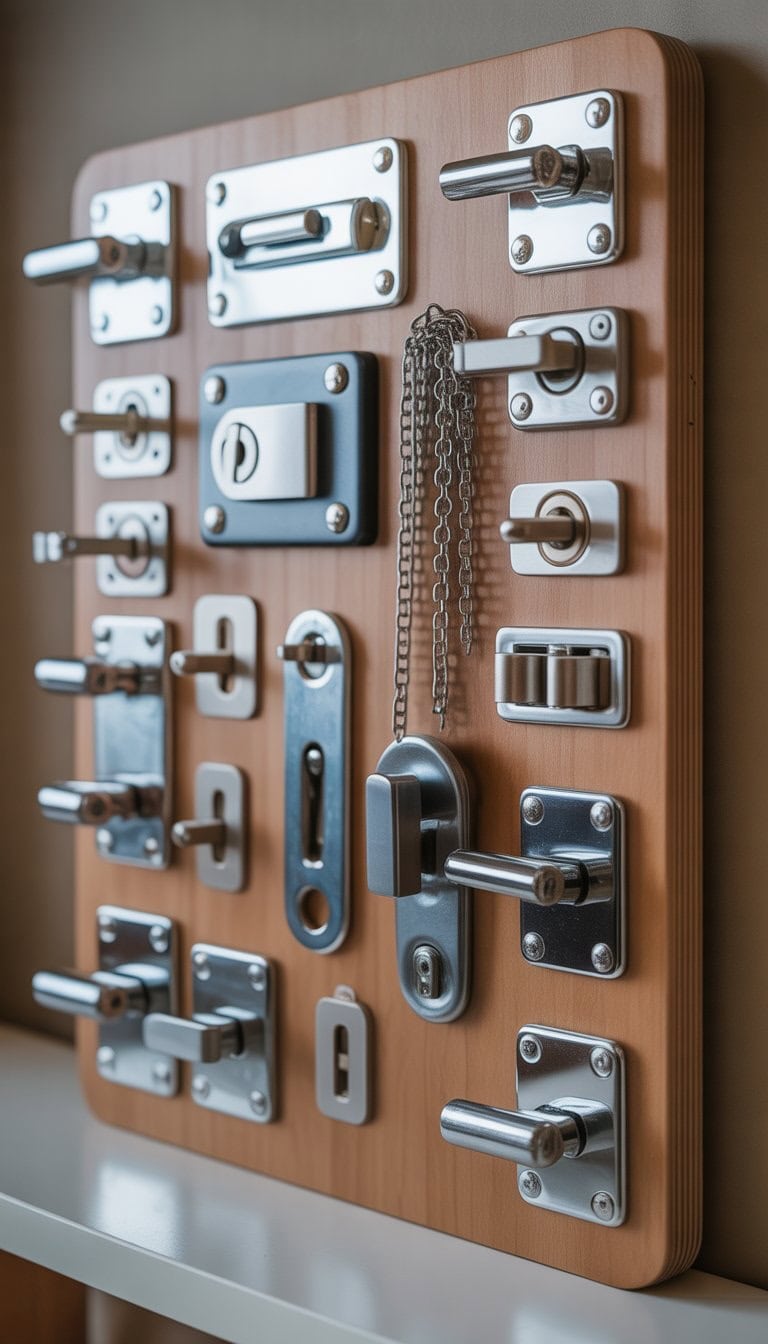
I love making busy boards with real hardware, like cabinet latches and door chain locks. These pieces remind me of exploring my own home as a kid, clicking and sliding different locks just to see how they worked.
When I build a latches and locks board, I pick a few different latch types. Cabinet latches, hook-and-eye locks, and door chain locks all bring something unique. The different motions, like sliding or twisting, keep little hands interested and learning.
I attach the latches onto a smooth wooden board. I always check that everything’s securely fastened and safe for little fingers. For ideas or ready-made options, I’ve found some great examples on the Melissa & Doug website and on Amazon.
Button and Snap Fastener Board with large colorful buttons and snaps
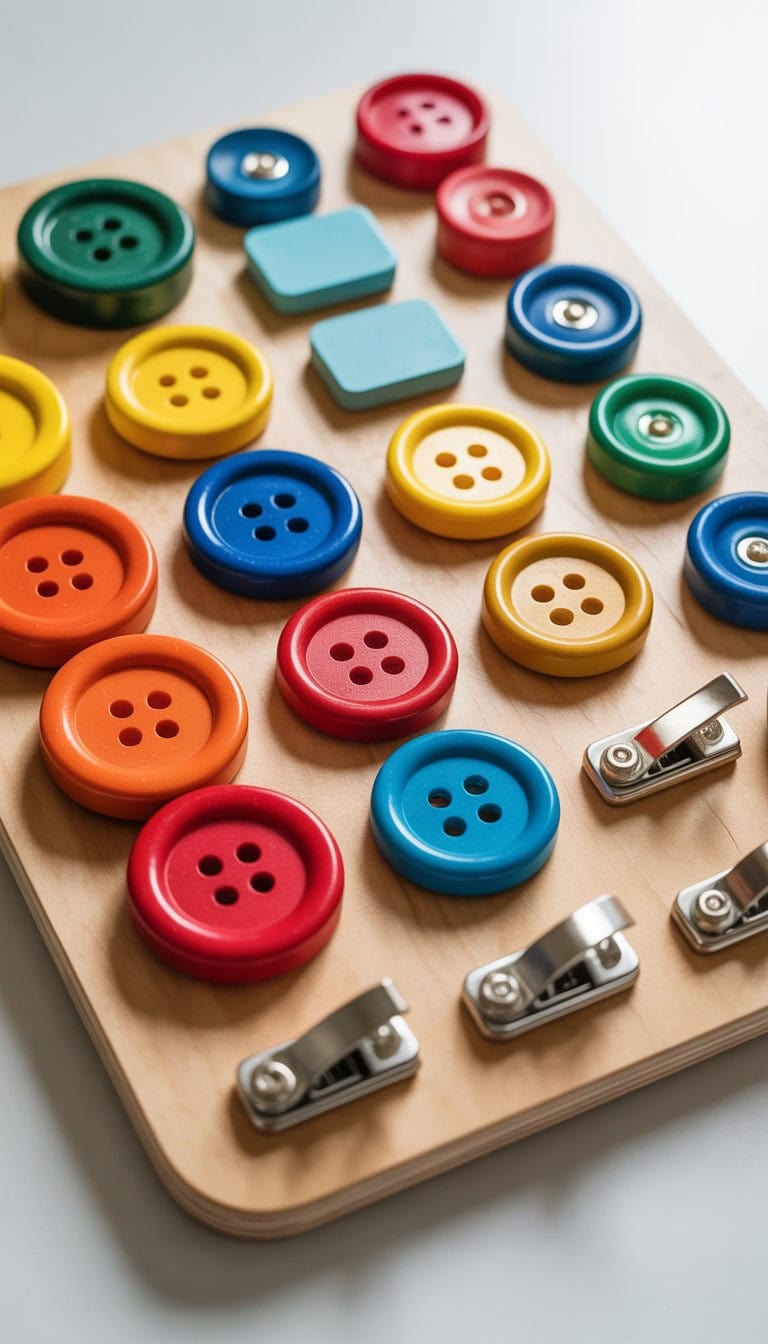
I love making a board full of big, colorful buttons and snaps for my toddler. Kids are naturally drawn to bright colors, and they always want to touch and move things.
When I set up large buttons, little hands can easily grab and push them through holes. I’ve noticed this helps my child practice finger strength and hand-eye coordination.
Snaps are also fun for toddlers to open and close. They give a satisfying click that makes kids want to keep going. This simple action teaches patience and focus.
If you want more ideas or ready-made choices, check out the button board options for toddlers. These boards also fit well with Montessori activities, letting children build real-life skills in a fun way.
Zipper Practice Board using different zipper types and colors
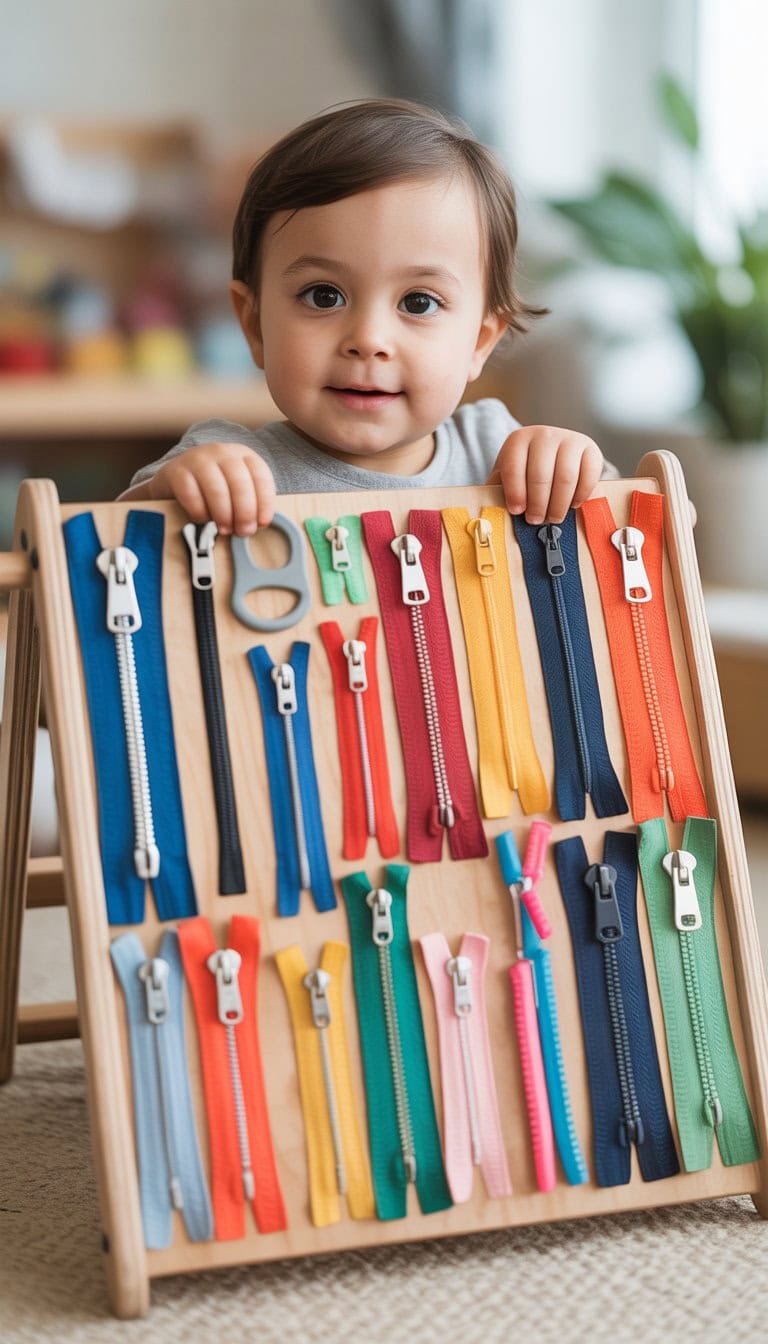
I love making busy boards that give my toddler real-life skills. One of my favorites is a zipper practice board with different types and colors of zippers. It’s simple to put together, and my toddler gets excited to try every zipper.
I use chunky plastic zippers, small metal ones, and even a few that curve or zigzag. Mixing up zipper styles keeps things interesting and helps little hands learn to grab and pull in different ways.
Bright colors make the board look fun and cheerful. I’ve found that my child likes to match the zipper colors with his shirts or toys. This kind of board is great for fine motor skills and learning independence. For more ideas on how to make one, check out this DIY zipper board for kids.
Light Switch and Outlet Plate Board for safe flipping and pressing
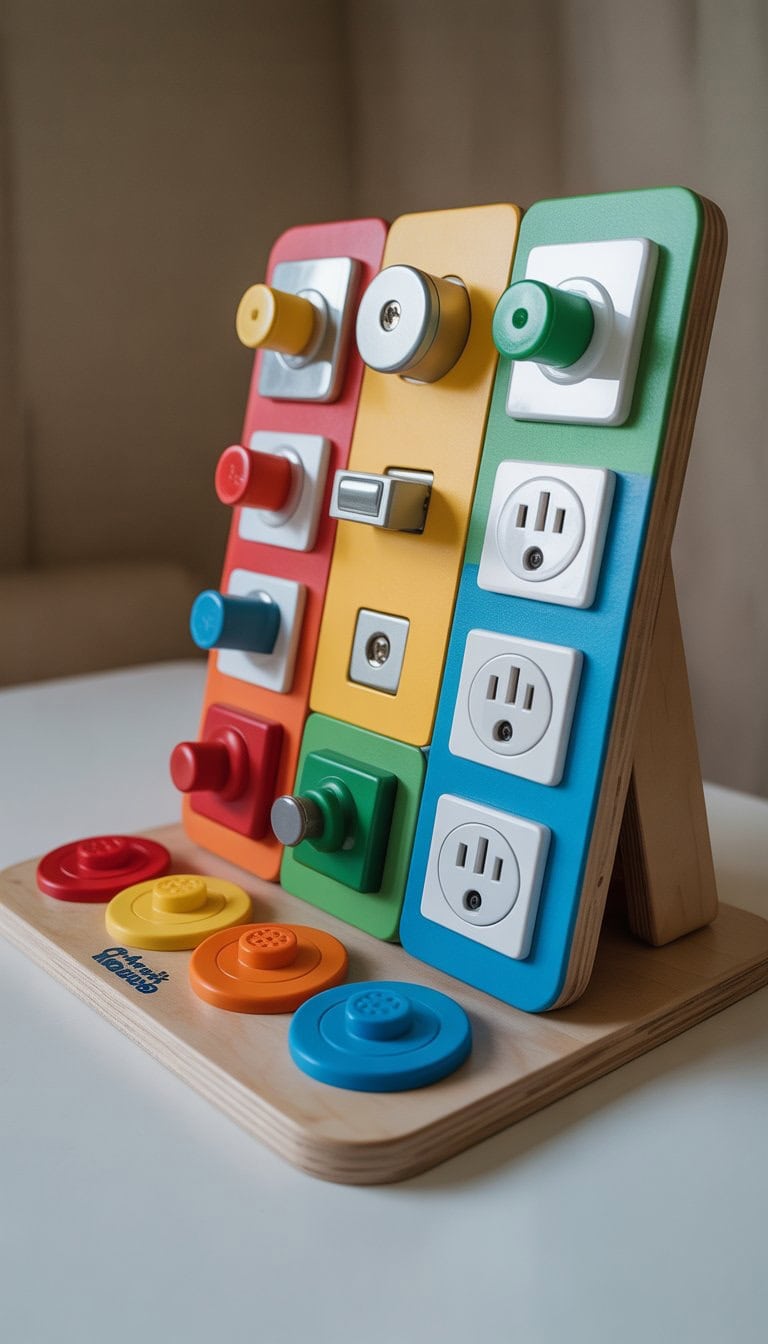
I love making busy boards with real light switches and outlet plates. My toddler gets so excited to flip the switches and press buttons. It’s an easy way to let them explore simple cause and effect.
When I built mine, I picked up extra switch and outlet covers from the hardware store. I made sure all the parts were safe—no real wires, just the covers and switches.
Watching my child focus as they flip the switches is always fun. The click and feel of these parts are very satisfying, and I’ve seen how it strengthens little hands.
If you want to add lights, I suggest using battery-powered LED switches, like some of the Montessori boards. This way, your child gets the visual reward with every flip.
Velcro and Ribbon Tying Board to develop fine motor skills

I love making a Velcro and ribbon tying board for my toddler. It’s an easy way to help those little fingers practice opening, closing, and tying. Velcro is great because kids can pull it apart and press it together again and again.
Adding ribbons gives a chance to play with tying and even simple knots. These simple actions help children learn skills needed for getting dressed. I’ve seen so much excitement when my toddler finally gets the bow just right.
A board like this is colorful and inviting. Plus, it can be part of a busy board collection for more learning. Every try helps kids gain confidence and independence.
Gears and Cogs Board with interlocking turning gears
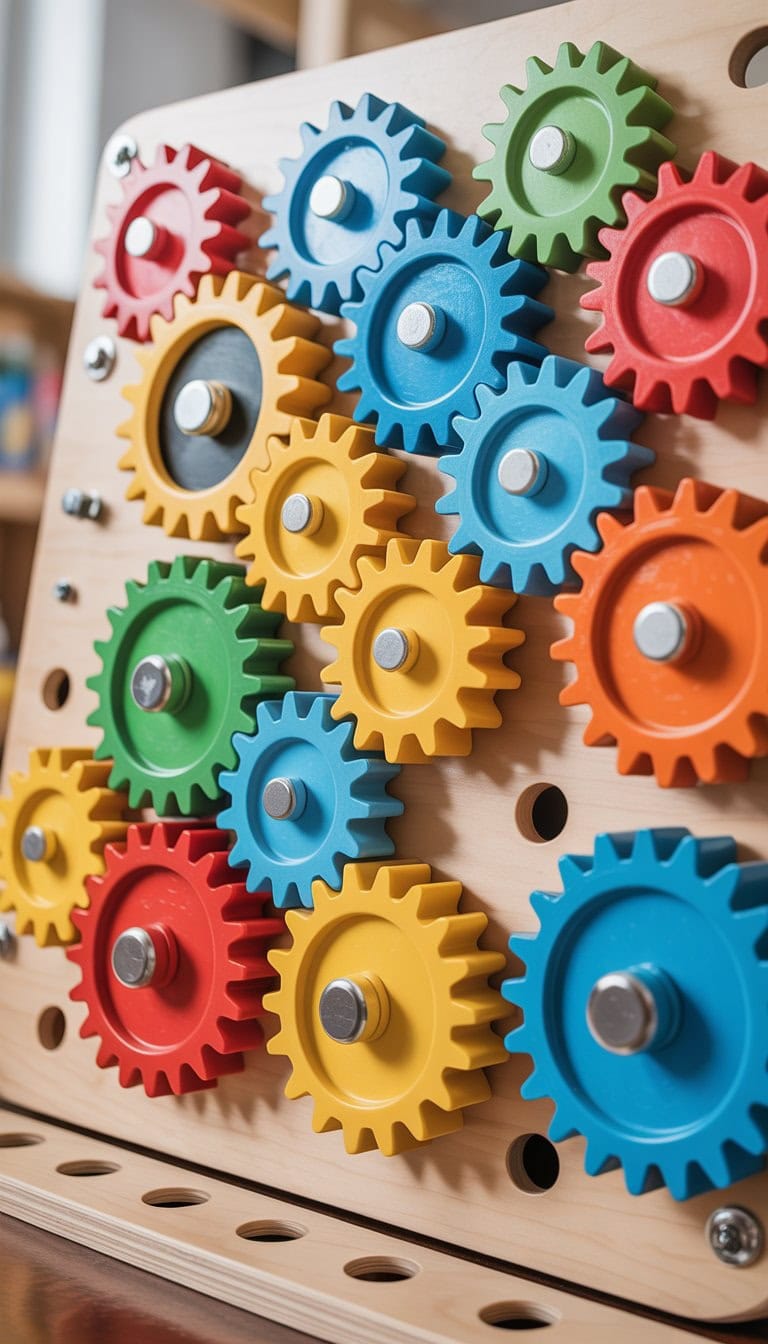
I love seeing my toddler’s eyes light up when they spin gears and watch them move together. A gears and cogs board uses interlocking gears that your child can turn by hand. When one gear turns, the others move too, showing how things connect and work together.
I always look for chunky, easy-to-grip gears so little hands can spin them with ease. The movement grabs their attention and helps them learn about cause and effect in a hands-on way. Some boards even have colorful wooden gears, which make playtime more fun.
Building a gears board at home isn’t hard. Simple wooden boards and a few plastic or wooden gears are all you need. For ideas and ready-made options, you can check out boards designed for toddlers like the SPARK & WOW Spinny Gears.
Sliding Door Puzzle Board with small sliding panels
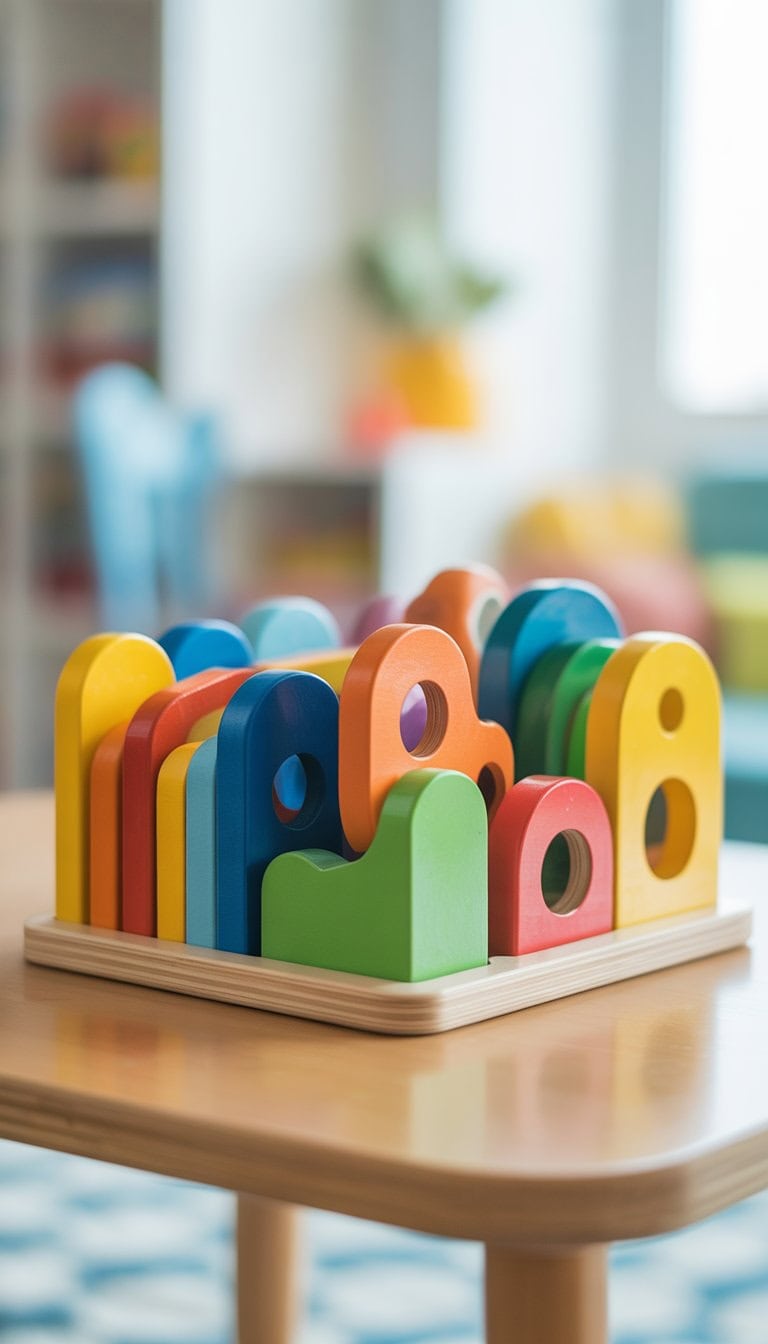
I love adding sliding panels to a busy board. Watching my toddler move the small doors back and forth keeps them busy and practicing coordination. These sliding panels are easy for little hands to grab and push.
I like to add pictures, shapes, or colors behind each sliding door. When my child slides a panel open, they get a fun surprise. It’s simple, but always gets a smile.
I made sure the sliding panels move smoothly and safely. There are no sharp edges, so I don’t worry about little fingers. The sliding door puzzle board helps my child build fine motor skills while having fun.
For inspiration and a step-by-step guide, I found this DIY busy board for toddlers very helpful. It gave me ideas for my own sliding puzzle design.
Clock Face Board with Movable Hands and Numbers
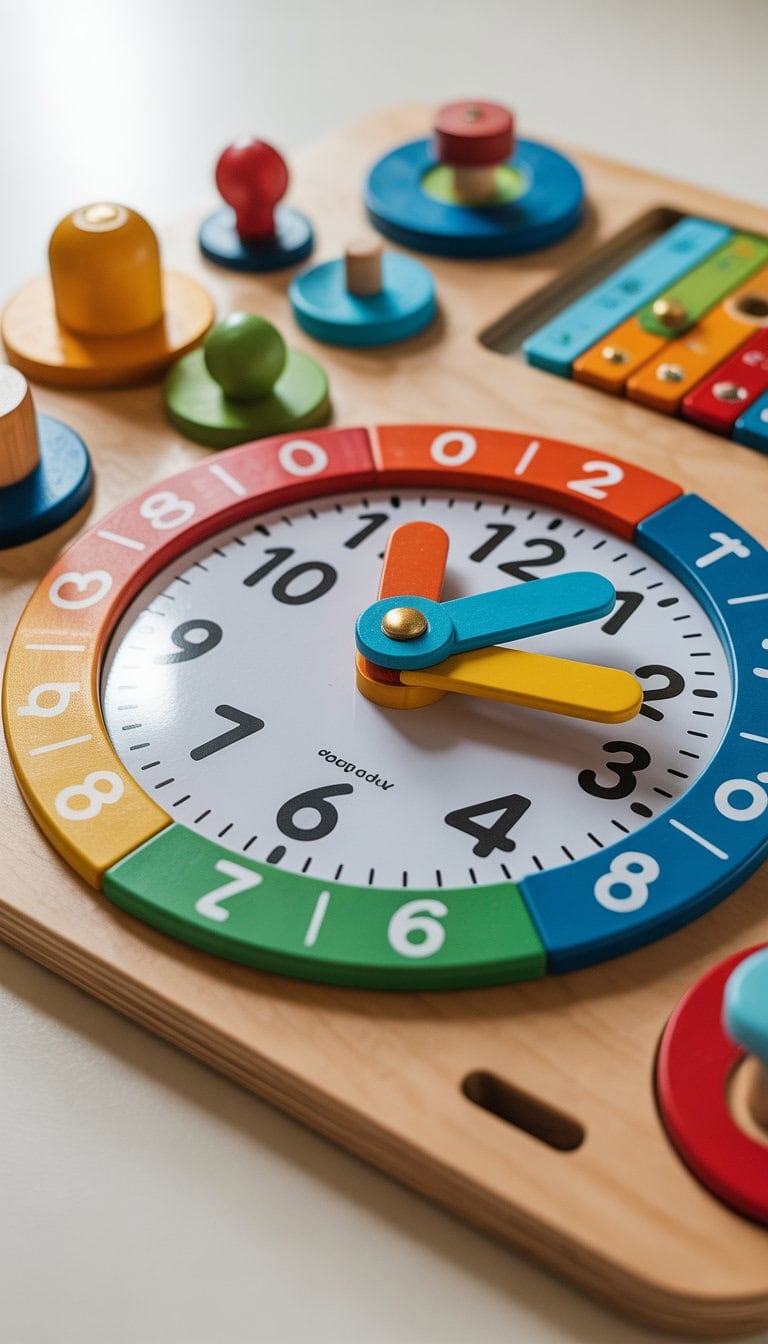
I love adding a clock face board to my toddler’s play area. It helps my child learn about time by moving the hands and seeing the numbers up close.
I used bright colors for the numbers and made sure each one was easy to see. The hands are sturdy but soft enough for little fingers to move without getting stuck.
Playing with a clock board lets my toddler practice fine motor skills. It’s also a fun way to start talking about daily routines and the concept of time. Some boards even include movable numbers so I can switch up the order for extra learning.
If you want ideas or instructions, you can find a step-by-step guide for making a busy board that includes activities like this.
Mirror and Reflective Surface Board for visual exploration
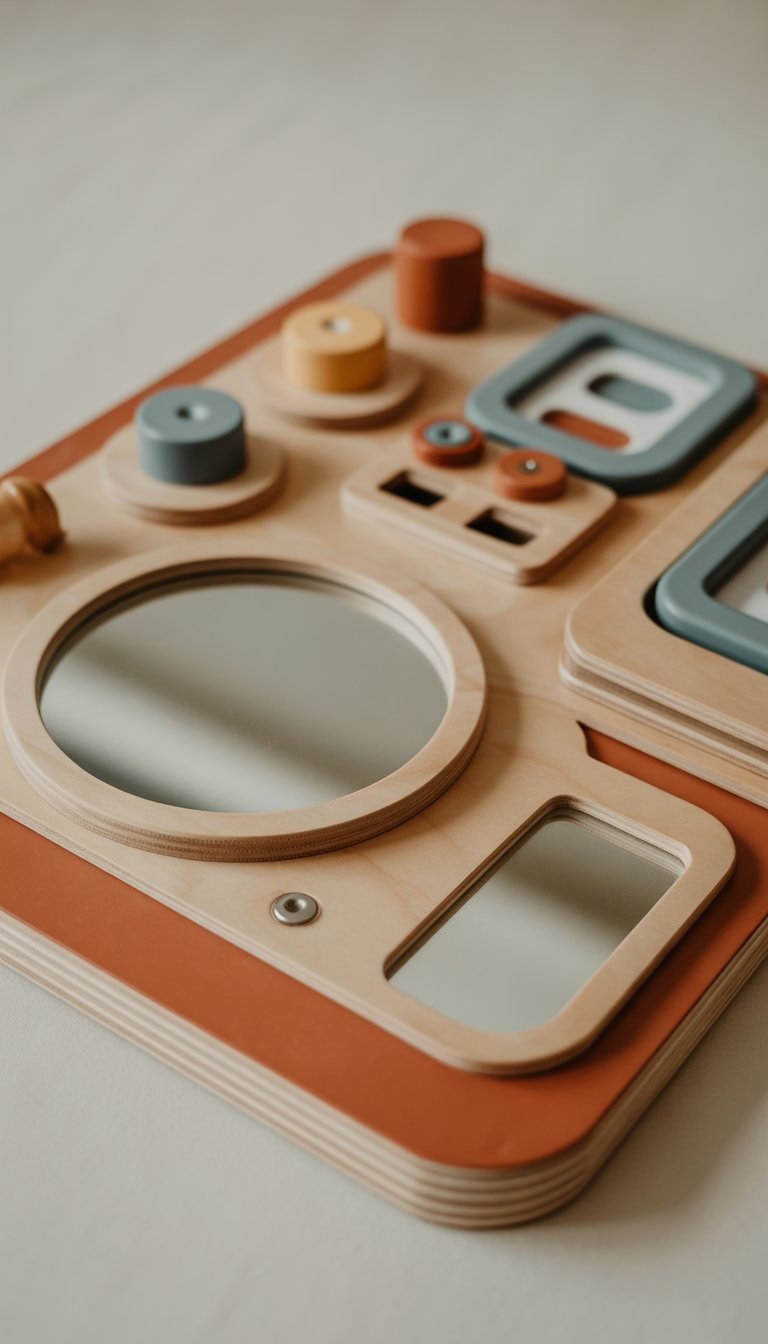
One of my favorite ways to encourage curiosity is with a mirror and reflective surface board. Little ones love to see their own face and watch the world in a new way. I find it’s a simple, yet powerful way to keep toddlers engaged.
I use unbreakable mirrors or shiny metal panels for safety. These materials are easy to clean and durable, which is important for busy hands. Sometimes I add textured or colored reflective paper to make things a bit more interesting.
As my toddler touches and explores the reflections, I notice new reactions each time. They make silly faces, point at themselves, and try to find objects in the mirror. It’s a joyful and interactive way to support visual development, and it never fails to bring a smile.
Shape Sorting Board with cutouts and matching blocks
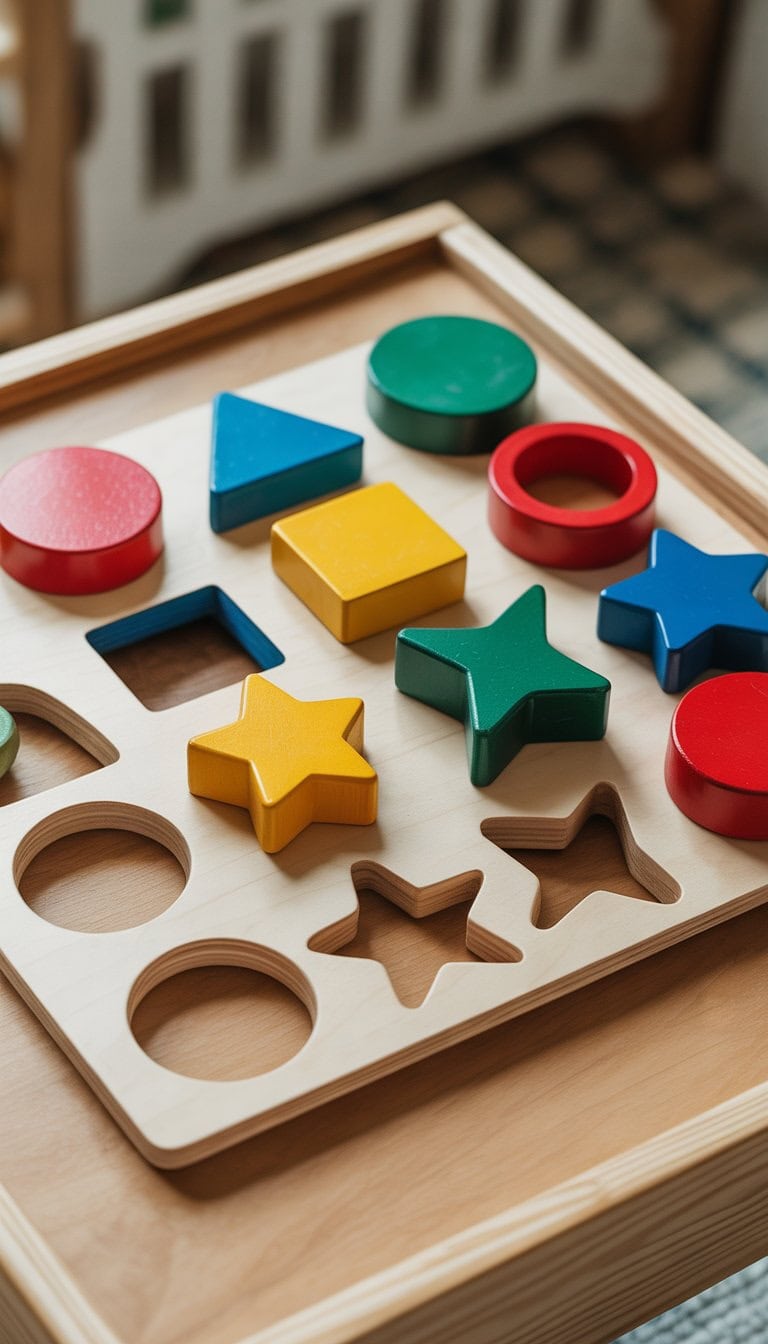
I love using a shape sorting board with my toddler. It has sturdy cutouts for colorful shapes and matching blocks that fit perfectly. Watching my child try different shapes in the cutouts always makes me smile.
This activity helps my toddler practice problem-solving. Picking up the blocks and matching them into the right spots makes a big difference in hand-eye coordination. We talk about colors and shapes as we play.
It’s fun to see how sorting boards get my child thinking. Each success builds confidence. There are so many possibilities for conversation, imagination, and learning with a good shape sorting board.
Bead Maze Board with colorful sliding beads
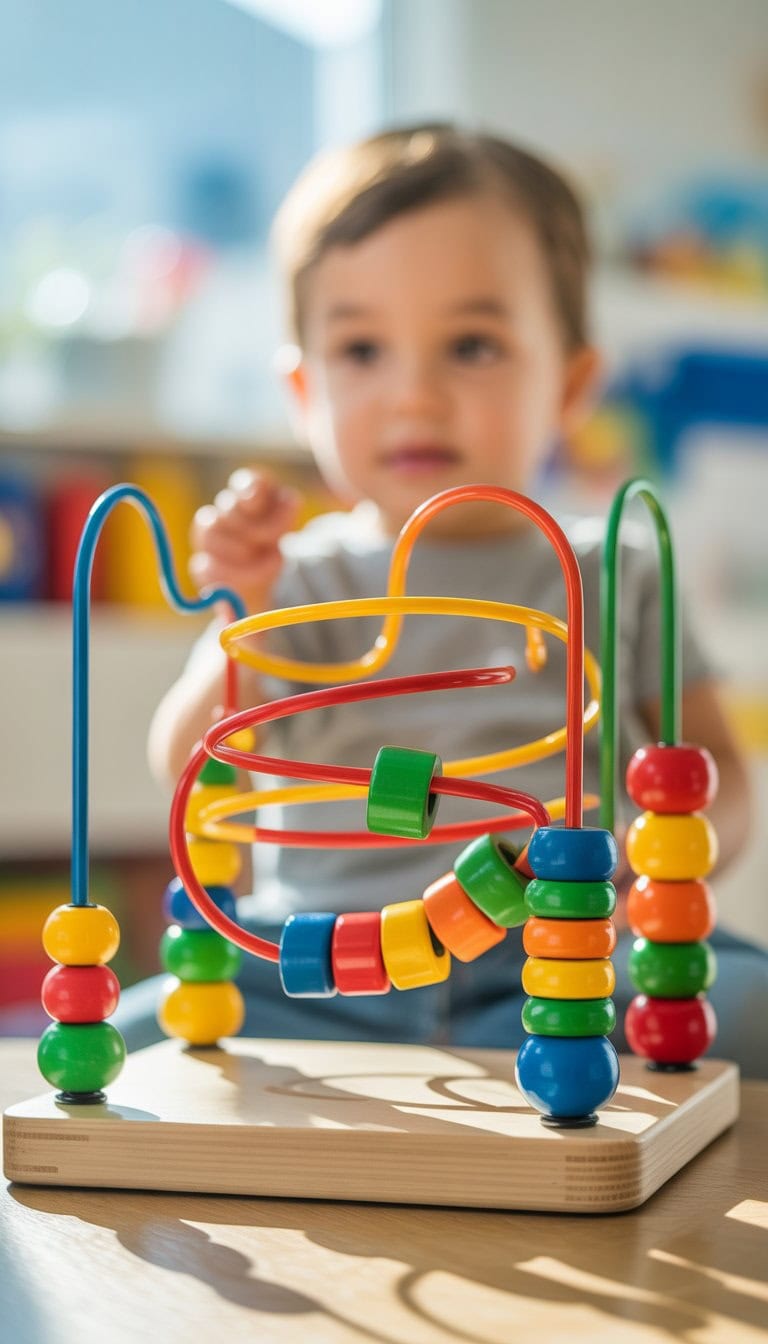
I always love adding a bead maze board to a busy board. These boards have bright, colorful beads that slide along curved wires. It catches my child’s attention right away.
Watching the beads twist and move along the path keeps little hands busy. I notice it helps my toddler practice fine motor skills and hand-eye coordination. Even the shapes and colors can help with early learning.
Many bead maze boards have cute themes like animals or fruits. I find a lot of great options with colorful sliding beads on Amazon’s best sellers list. Setting up a bead maze board is easy, and it always brings playful energy to our busy board setup.
ABC and Numbers Velcro Board with detachable pieces
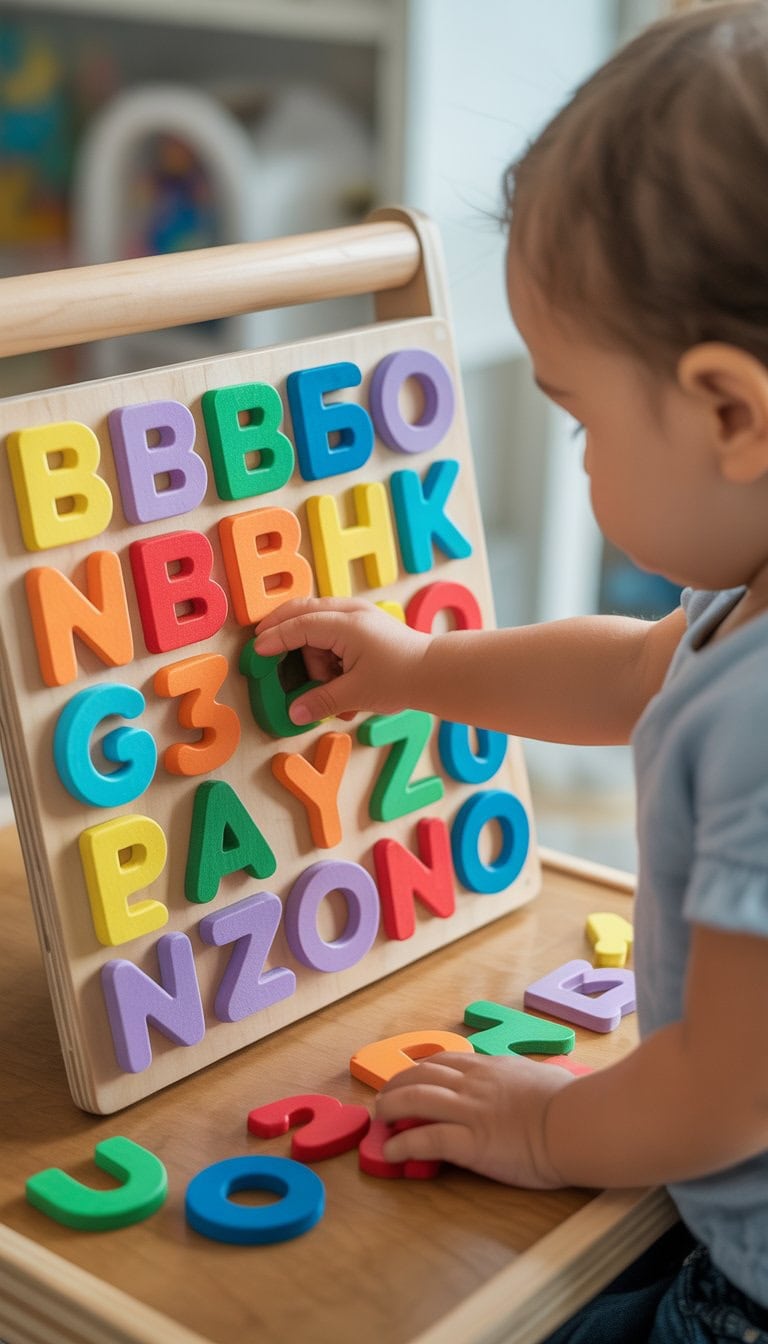
I love using an ABC and numbers Velcro board with my toddler. It lets them match letters and numbers to the right spots, which helps them learn shapes and sounds. The Velcro makes each piece easy to stick on and pull off.
I make sure to use bright colors, which always grab my child’s attention. Sometimes I even hide the pieces and turn finding them into a little game. It keeps my child moving and thinking.
Velcro boards are versatile. I can swap in simple words or number problems as my child grows. Some of these boards, like the ones you can find on Etsy’s Velcro busy board selection, are handmade and very creative.
Clothespin Pinching Board with wooden clothespins

I love how simple this clothespin pinching board is to put together. All I need are wooden clothespins and a sturdy piece of cardboard or a board. I space out the clothespins along the edges or draw lines to help show my toddler where to pinch and place them.
Pinching and placing each clothespin really helps build hand strength and fine motor control. I notice my toddler focusing hard, picking up each pin with care, and feeling proud when it clicks into place. Sometimes I write colors or numbers on the board for even more learning.
This easy activity keeps my child engaged and busy, and I can change it up any time. If I’m looking for more inspiration, I sometimes check out ideas like the clothespin activity for toddlers for new ways to use clothespins.
Shoe Tying Practice Board with different types of shoes
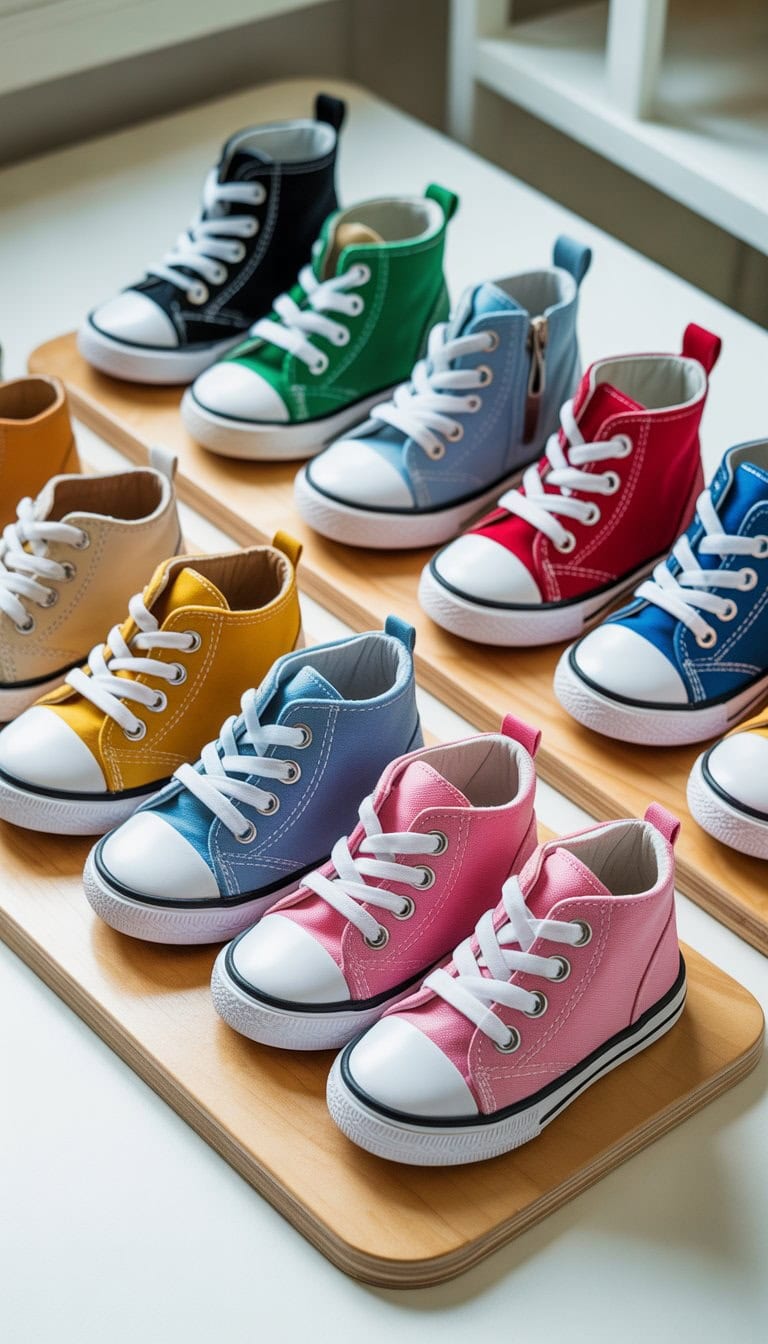
When I started teaching my child how to tie shoes, I looked for ways to make it fun and easy. A shoe tying practice board quickly became one of my favorite tools. I added different types of shoes, like sneakers, sandals, and boots.
Each shoe has its own laces, buckles, or Velcro straps. My child could practice with many kinds of fasteners without getting bored. This kept things interesting and helped them learn new skills.
Having more than one style on the board also built my child’s confidence. They were proud when they could tie laces, buckle sandals, and zip up boots all by themselves. I noticed that busy boards with tying shoe laces are easy to find online. Some even come with bright colors and soft materials, perfect for little hands.
Musical Board featuring attached tambourine and drum stick
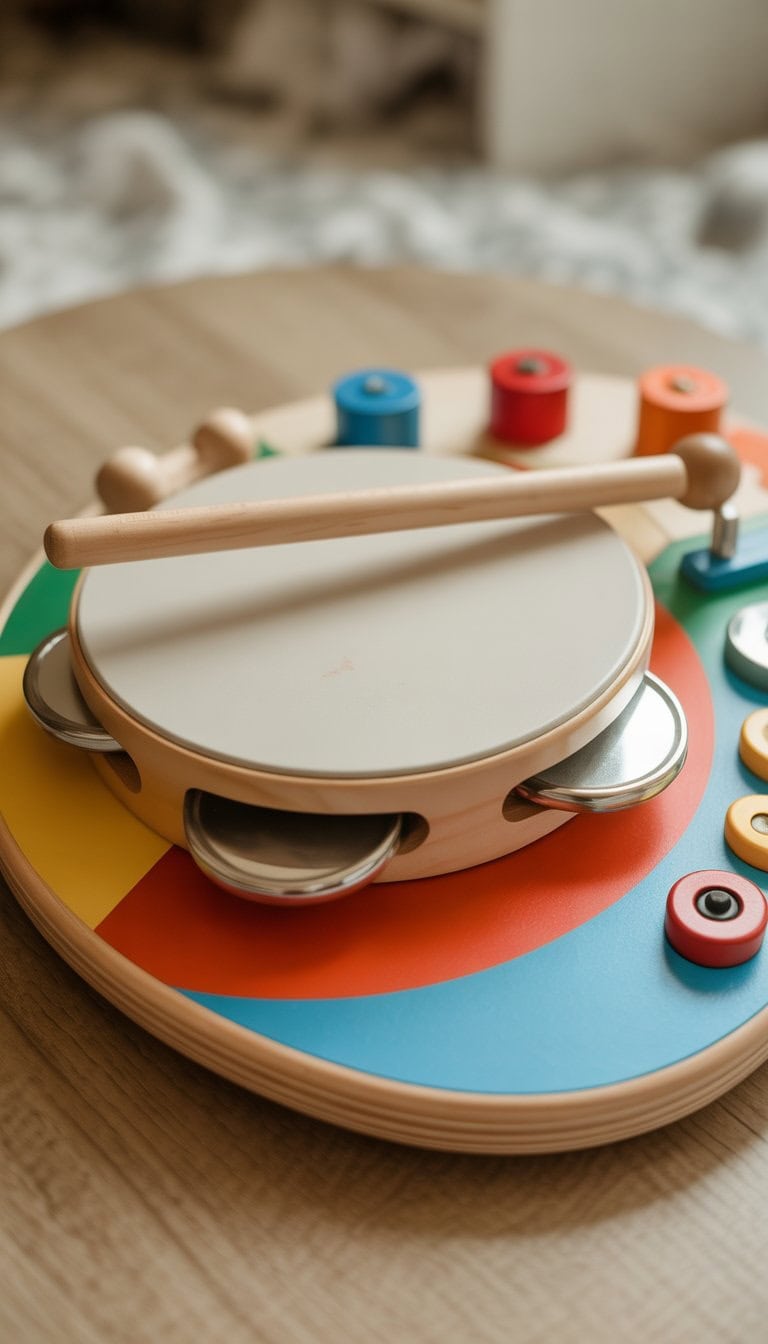
When I made a musical board for my toddler, I focused on simple instruments. I attached a small tambourine and a wooden drum stick to the board.
My child loved the sound of tapping and shaking the tambourine. The drum stick gave them a different way to explore rhythm. I noticed their interest in music grow each day.
Adding music to the busy board kept playtime active and fun. I felt good knowing my child practiced hand coordination while exploring new sounds. If you’re interested, you can also find inspiration from music busy boards.
I recommend making sure all pieces are safely fastened. I always checked for any loose parts before play. This small musical board became one of my child’s favorite activities.
Color Matching Board with paint swatches and buttons
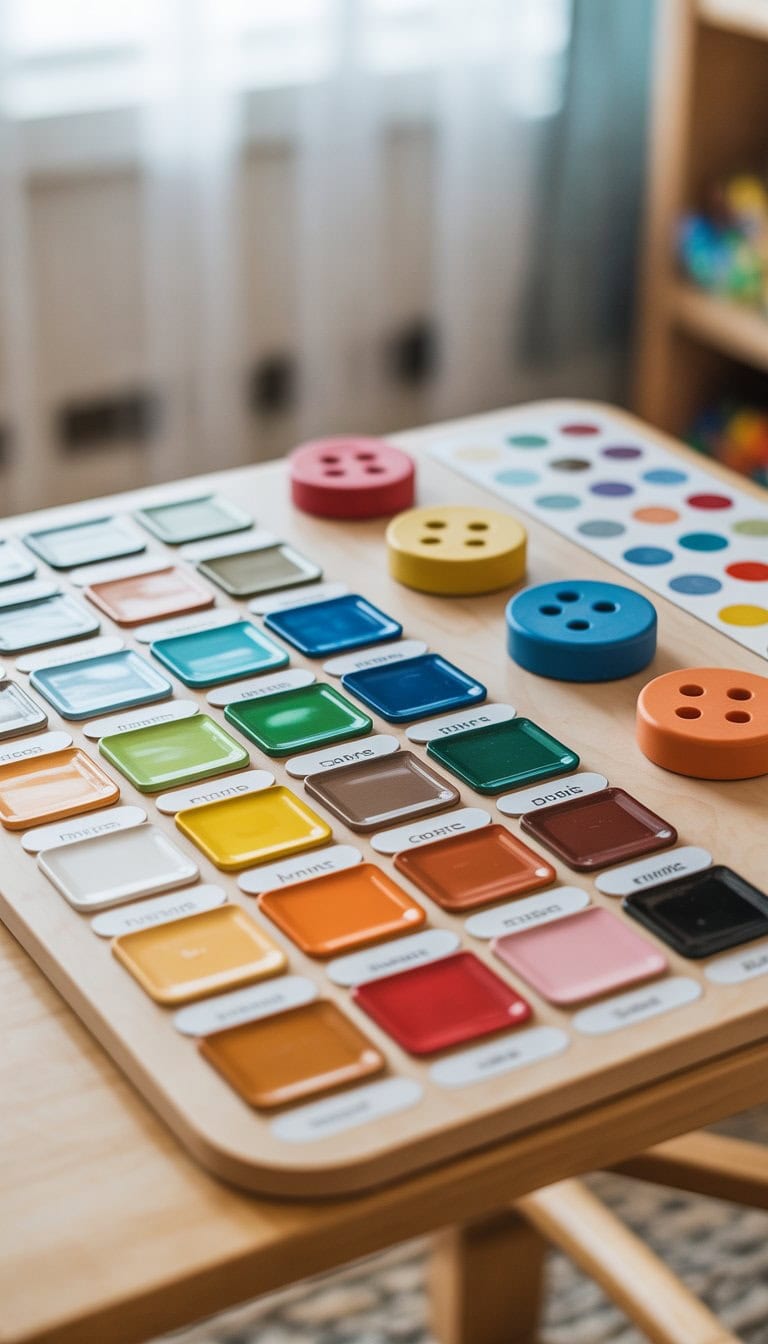
I love making simple activities for my toddler, and this color matching board is one of my favorites. I grab a handful of paint swatches from the hardware store and lay them out on a sturdy piece of cardboard.
Then, I find large colorful buttons that match the paint swatches. My child enjoys picking up each button and placing it on the right color. It’s a fun way to help them learn their colors and practice sorting.
This game is easy to put together and doesn’t take much time. Busy bags like this are great for travel or quiet moments, and you can see more about this idea at Paint Chip Color Match Game.
Magnetic Board with alphabet magnets
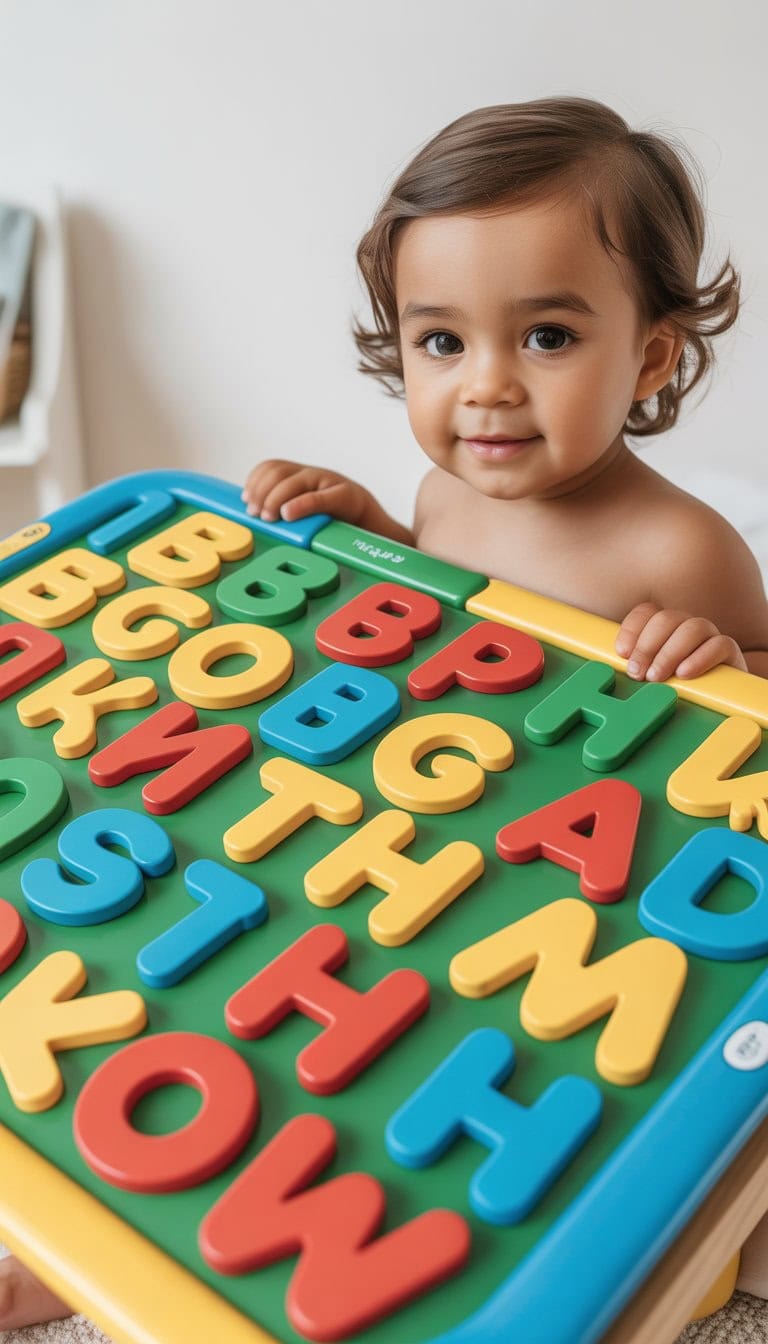
I love how a magnetic board with alphabet magnets makes learning fun and hands-on for my toddler. The bright letters stick right to the board, so my little one can move them around and spell easy words.
This simple busy board idea helps build letter recognition and early reading skills. I’ve noticed how my child enjoys matching and sorting the colored letters. Many sets use color to show vowels and consonants, making it extra clear (Amazon magnetic letter set).
Setting up the board only takes a minute. I can put it on the fridge, wall, or a table. My toddler always feels proud after spelling their name or favorite word.
Trigger and Button Pressing Board for cause-and-effect play
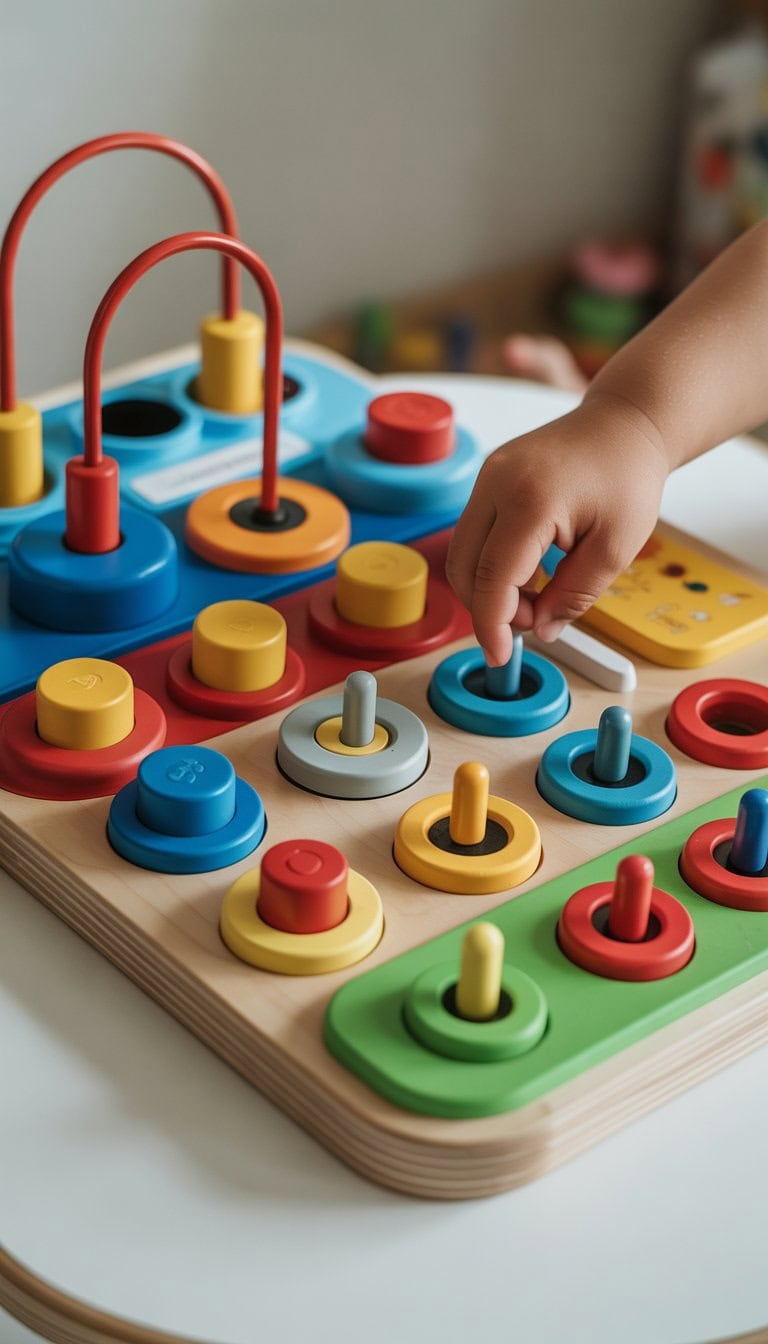
I love watching my toddler explore a trigger and button pressing board. Each press or flip unlocks a little surprise, like a light turning on or a buzzer making a sound. It helps my child learn simple cause-and-effect skills in a hands-on way.
I set up big, easy-to-press buttons and sturdy switches. The feedback from each action, like a soft click or a bright LED, keeps my child engaged and curious.
Toddlers enjoy pressing and flipping things, and a board like this lets them play safely. It’s just like the DIY busy boards I’ve seen online—simple, satisfying, and perfect for little hands.
Every time my toddler figures out how to make something happen, I see a spark of pride.
Knobs and Handles Board with various cabinet knobs
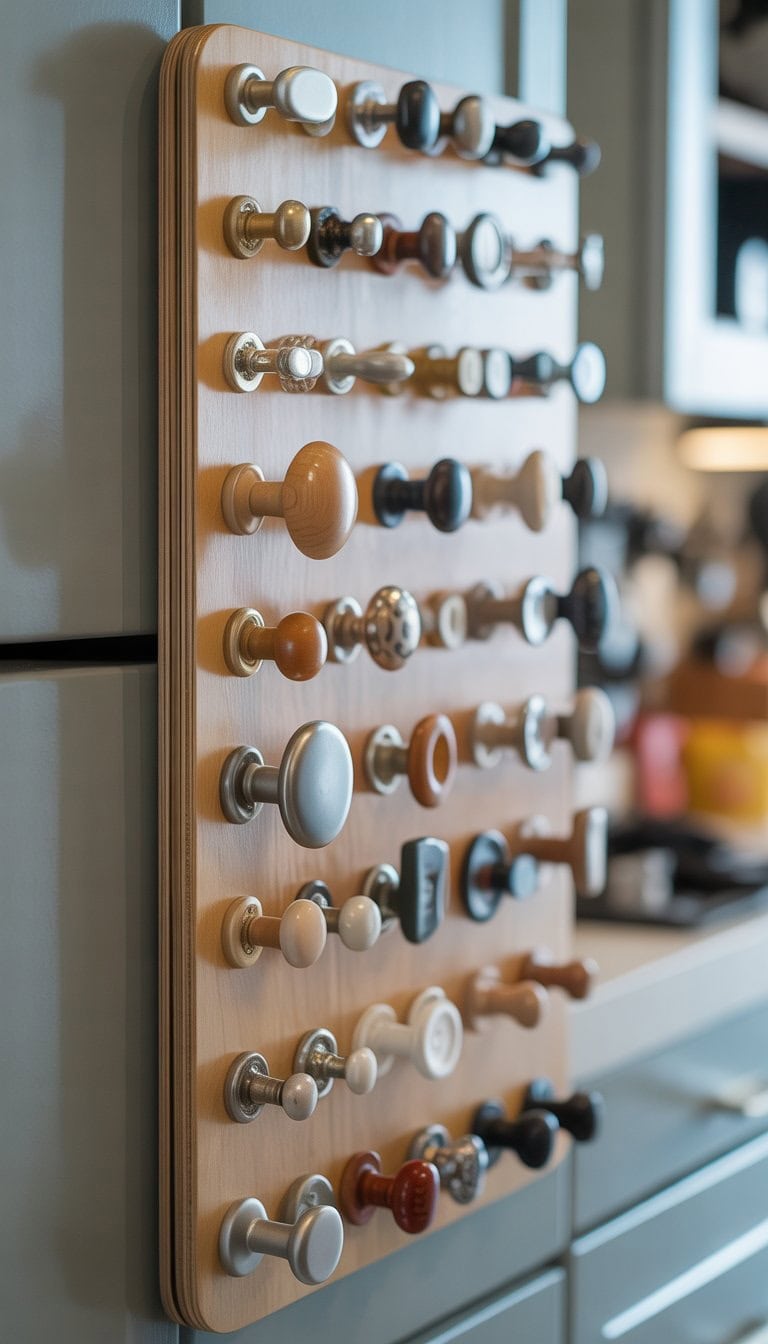
When I made a busy board just with cabinet knobs and handles, I saw how much my toddler loved it. Kids have fun turning, pulling, and twisting all the different shapes and sizes. It’s a simple way to work on hand strength.
I picked up a few knobs and handles at the hardware store, making sure to choose safe edges and materials. There are so many fun styles, from old door knobs to modern drawer pulls. Each one brings a new way to practice fine motor skills.
I found that adding handles lets my child try different grips and move their hands in new ways. If you want more ideas, you can also check out how others use knobs and handles on busy boards for toddlers.
Chain and Hook Linking Board for coordination
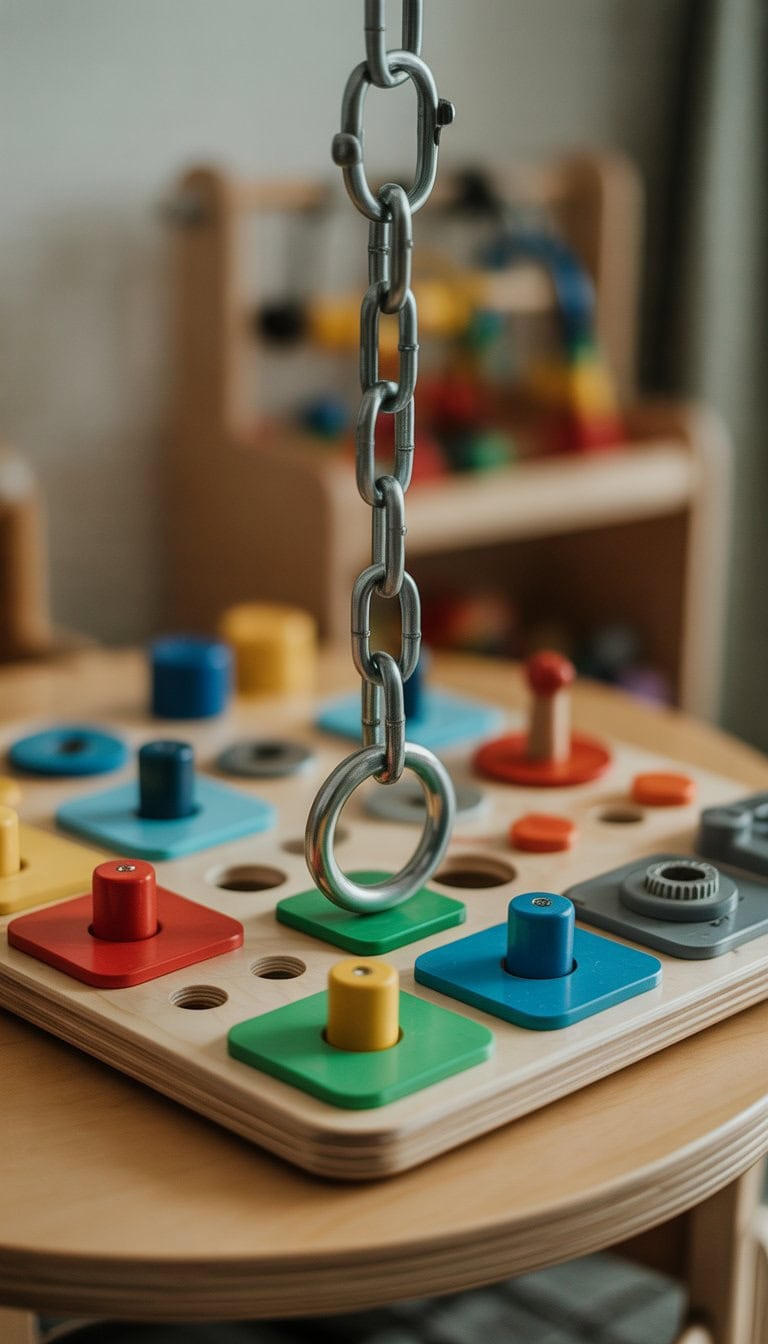
I love how simple items like chains and hooks can teach my toddler so much. A chain and hook linking board is all about practicing coordination and building confidence. Every time my child moves a chain or fastens a hook, I see those little hands getting stronger and more skilled.
I add strong chains of different sizes and easy-to-turn hooks to the board. I keep the height low, so my toddler can reach every part. It becomes really fun to move the hooks in and out or loop the chains through rings.
I notice these activities help with patience too. Small tasks like linking a hook take focus, but seeing my child succeed makes it worth every second. Busy boards like this are a great way to have hands-on fun while learning at home.
Rope and Pulley Board with small pulleys and ropes
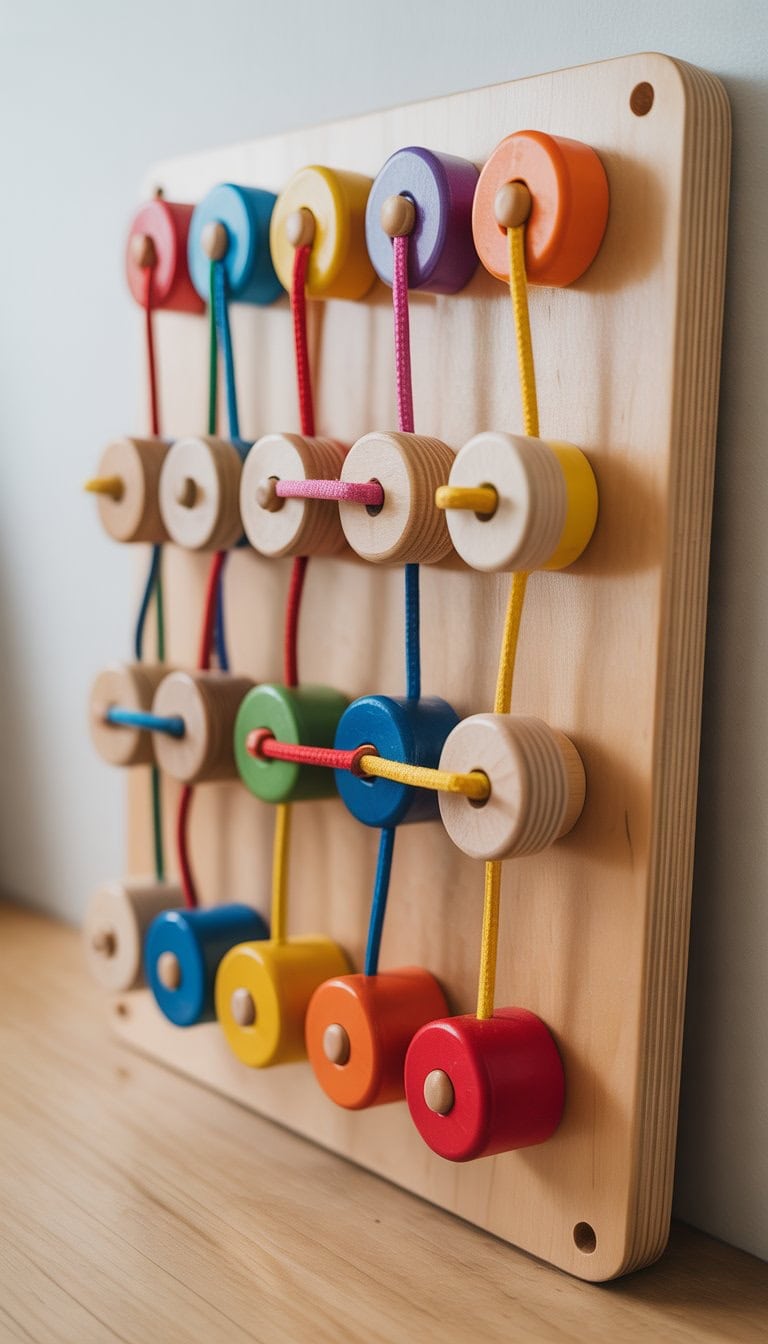
I love making a rope and pulley board for toddlers because it’s all about exploring and figuring things out. Kids are always curious about how things move, and a simple board with small pulleys and ropes keeps those little hands busy.
I use sturdy ropes and attach a few lightweight pulleys onto a wooden board. My little one enjoys pulling the ropes back and forth, watching the movement, and figuring out direction and force.
This kind of busy board encourages kids to solve problems and work on hand-eye coordination. If you want to see other ideas and a step-by-step guide, check out this helpful post on how to make a busy board for toddlers.
Teething Friendly Silicone Texture Board
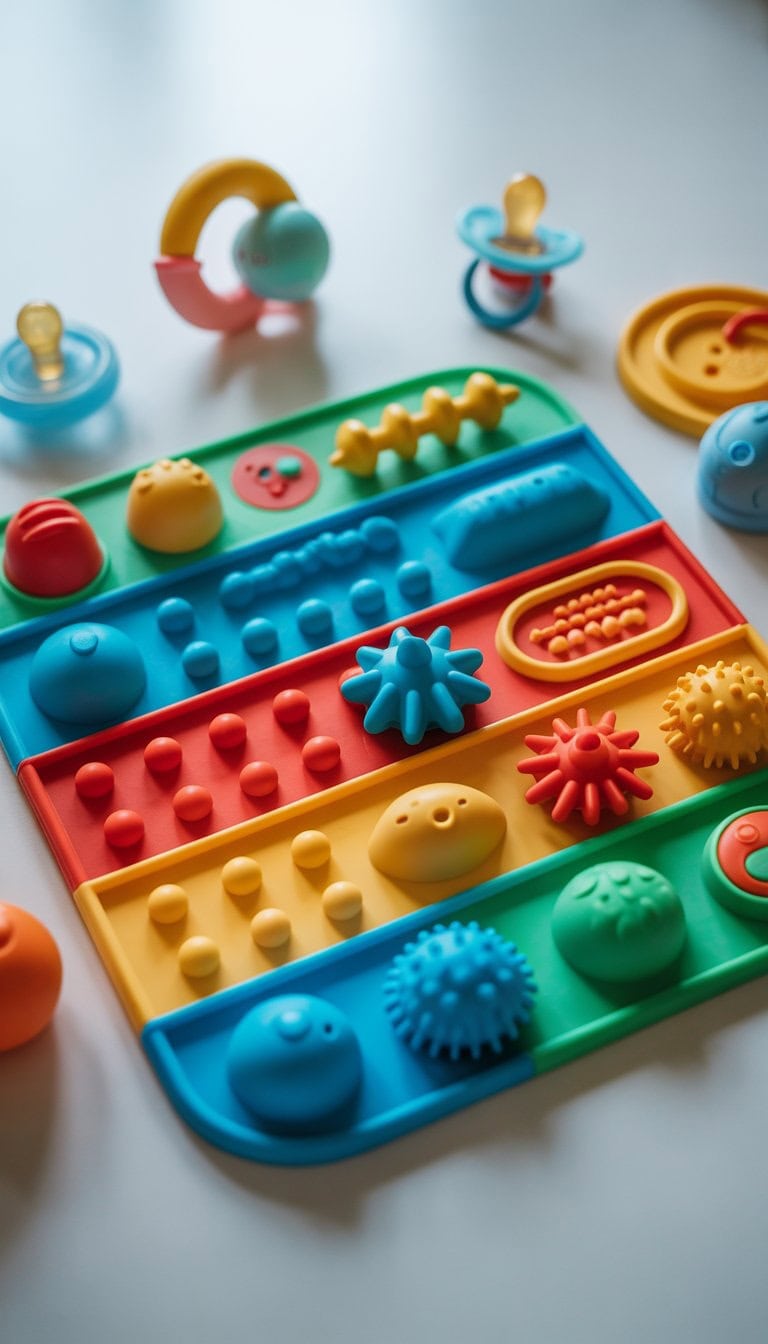
When I made a teething friendly silicone texture board for my toddler, I wanted something safe for sore gums and curious hands. I picked soft, food-grade silicone for the board’s main pieces so chewing was totally safe.
Different textures from smooth bumps to wavy lines gave my child a new sensory experience every time. My little one loved exploring and gripping the squishy surfaces.
This kind of board is also easy to clean, which mattered to me because babies love to drool and chew. I saw right away that simple silicone shapes on a busy board can be both soothing and fun for kids who are teething.
If you want ready-made options, you can check out busy boards designed for toddlers that focus on both teething and sensory play.
Choosing Safe And Engaging Materials
I always put safety first when picking materials for a busy board. Using sturdy, non-toxic, and sensory-rich supplies keeps my toddler interested and gives me peace of mind.
Non-Toxic And Durable Options
When I make a busy board, I only use items that are non-toxic and tough. Many busy boards are made of high-quality wood with smooth edges that prevent splinters. Anything that goes on the board, like knobs or wheels, should be firmly attached so nothing becomes a choking hazard.
It’s smart to look for paints, glues, and finishes that are labeled as child-safe or non-toxic. I check labels for certifications, like ASTM or EN71, to make sure they meet strict child safety standards.
To keep things lasting longer, I choose hardware and parts that are meant for frequent use. For example, metal hinges and secure screws hold up much better than plastic ones. Boards designed with safety in mind, such as eco-friendly wooden options with smooth finishes, can last through years of play.
Eco-Friendly And Sensory Choices
Eco-friendly choices matter to me, so I lean toward sustainable materials whenever I can. Recycled wood, organic cotton ropes, and reclaimed hardware not only lower my impact, but also look and feel interesting. Boards made from eco-friendly wood are gentle on the earth and safe for kids, too.
I love adding a mix of textures to the busy board. Felt, natural fabrics, soft rubber, and smooth wood each give my child a new way to touch and explore. Sensory play helps grow fine motor skills and keeps things exciting.
Things like bells, buckles, and zippers add even more variety. Some of the best ideas I’ve found are Montessori-inspired boards, which use real-life objects in kid-safe ways. I always double-check everything is fixed in place and does not contain small, loose parts.
Creative Ways To Personalize Busy Boards
I love making busy boards feel special for my child. By including their favorite characters or adjusting the board for their age, I can keep them interested and excited to play every day.
Adding A Child’s Favorite Themes
It’s meaningful when I design a busy board using my toddler’s favorite things. I like to pick a theme, such as dinosaurs, outer space, or animals, and use colors, stickers, and pictures to decorate the board. Sometimes, I glue on small plastic toys or use cutouts for added fun.
If my child loves cars, I attach little steering wheels, gear shifters, or soft wheels to spin. For animal themes, I might add felt animal faces or knobs shaped like animal heads. Labels and knobs shaped like stars or rocket ships fit right in for a space board.
Here’s a quick list of personalized touches I often include:
- Photos of family, pets, or favorite characters
- Custom name plates using wood letters or foam stickers
- Unique textures like fake fur, ribbon, or sequins for tactile play
Pictures from boards shared on Pinterest have given me inspiration for these themed ideas. Each board feels more personal and engaging when I tailor it this way.
Customizing For Different Ages
As my child grows, I adjust busy boards to match their new skills. For toddlers, I focus on simple items like large buttons, big zippers, switches, and soft flaps. These are easy for little hands and help build coordination.
When my child gets older, I start adding pieces that are a bit more complex or challenging:
- Shoe laces or velcro straps for practicing tying and fastening
- Locks, latches, or small gears for problem solving
- Simple puzzles or spinning wheels to challenge their thinking
The key is to keep it safe and age-appropriate. I always check that small parts are securely attached and avoid tiny items that could be a choking hazard. Ideas I find on Reddit help me decide what activities are right for different ages and stages, so my child always has something new to discover.
Frequently Asked Questions
I’ve had a lot of practice making busy boards for my little one. From which wood lasts the longest to keeping things safe for travel, I’ve learned what really matters and what gives the best play experience.
What items capture a 2-year-old’s attention on a busy board?
I’ve found that toddlers love surprises and texture. My board has sandpaper, fuzzy squares, and bumpy plastic shapes for sensory fun.
Cabinet latches, door chain locks, light switches, and outlet plates keep curious hands moving. Large colorful buttons, snaps, and easy zippers also capture their attention for longer periods.
How can I create an easy DIY busy board for my toddler?
I start with a simple, smooth wooden board. Then I collect safe household items like light switches, doorknobs, zippers, and different fabrics.
I use a drill to attach everything firmly, making sure nothing has sharp edges. Some helpful tips can be found in this busy board how-to guide.
Which type of wood is ideal for crafting a durable busy board?
When I’m making a busy board, I prefer plywood. It’s affordable, easy to work with, and strong enough for active toddlers.
Pine is another good option. It’s sturdy and won’t splinter if I sand it well.
Can you suggest some ideas for designing a travel-friendly busy board?
To make a travel board, I use a lighter, smaller base. I keep the pieces flat or only a little raised so they’re not bulky.
I attach a handle or use Velcro straps to wrap up the board. I also avoid metal or sharp items, sticking to soft fabrics, zippers, and plastic snaps. For more travel board ideas, Pinterest offers some great DIY inspiration.
What are the benefits of busy boards for toddler development?
I’ve seen my child’s fine motor skills improve a lot from using busy boards. They learn how to open latches, fasten buttons, and zip closures.
Busy boards also build curiosity, problem-solving, and independence through hands-on play. They’re especially helpful for sensory development and practicing everyday skills, as explained in this detailed breakdown of their benefits.
Any tips on making a busy board free-standing for active toddlers?
I use two wooden support legs attached at the back so my board stands upright on its own. Sometimes I use hinges so it folds out like an easel for extra stability.
Making sure the base is wide enough helps stop the board from tipping over, even if my toddler pushes or leans on it.
